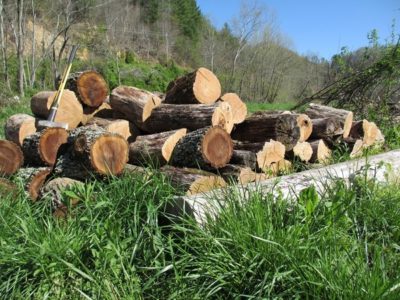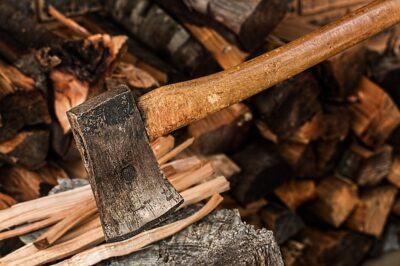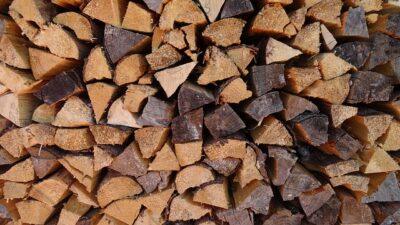For people who have lived with wood heat for years, firewood is pretty much a no-brainer – just another part of living in the country. But people who have just moved to a home that relies on wood heat or just installed a wood stove might not find it so simple.
Here is a brief rundown on selecting, buying, splitting and storing firewood for the beginner – and in making sure you have more than enough for the season.
Types of Wood
When it comes to type of wood, there are four categories to keep in mind:
- Hard vs. soft
- Green vs. seasoned
Hardwoods and softwoods refer to the type of tree. Hardwoods like oak will burn longer and create a nice coal bed. Softwoods like pine will burn hotter and more quickly. An ideal woodpile should have a mix of these dense and soft woods. Softer woods tend to make good kindling and help to get the fire going before adding bigger piece of hardwood. Softer woods also are useful for getting a room heated more quickly, whereas hardwoods will maintain the heat and last throughout the night if maintained properly.
Softwoods also can be nice to have in the spring and fall when you only want to warm your house in the morning to take the chill off. Keep in mind that some softwoods like pine can have a lot of sap in the wood, even after seasoning. This can cause a creosote build-up to happen more quickly, so keep that in mind.
The terms green and seasoned refer to the age and status of the firewood. Green wood is newly processed firewood that still has a lot of water content. Naturally this water content is going to make the wood difficult to burn and also might cause gunk to gather in the chimney. It just isn’t efficient. Seasoned firewood is wood that has been split and stacked, then allowed to sit in storage to dry. Depending on the wood, you can season firewood well in about six months. But some people choose to gather a ton of firewood a year or two in advance to ensure they have plenty of nice, dry wood.
It’s best to get your firewood in the spring if it’s green so it has time to dry by late fall or winter, depending on your climate. Seasoned wood costs more money and is more difficult to find.
Buying vs. Gathering
When deciding whether to buy or gather your own firewood, you should consider a few things. If you live on some acreage with trees it can be tempting to want to play lumberjack. But take a moment to think about that. If you are brand new to woodlot management, you can do a lot of damage to your property if you haphazardly take trees without considering the long-term effects. Aside from that, say there are some damaged or already fallen trees you have your eyes on. That would be fine to take but you will need to learn how to safely use a chainsaw and should have someone else with you in case of an emergency. Even experienced chainsaw users can become complacent and end up hurting themselves. Learning to use a chainsaw is an important skill for anyone who lives in a rural area. Just be sure you educate yourself either from the help of a friend, a class, or online videos before cutting trees.
Cutting and gathering your own firewood is quite a laborious process, especially since you’ll still have to split and stack it at home. If that is something you’re interested in and you have the time to do it, by all means go for it. But keep in mind that your firewood pile may not be seasoned by the time you are done. If it’s your first year with wood heat, it would be a better idea to start gathering wood but also buy enough for the first winter.
If you’re in a rural area you can find ads for firewood in the local newspaper, online (like Craigslist) and through word-of-mouth. If your town is like mine, you might even see trucks loaded with wood and a sign with a phone number as an advertisement. For most people it’s easiest to just ask friends if they know a good source of firewood in the area.
When buying firewood be sure to ask whether the wood is seasoned. You also should inspect the wood yourself before paying. It’s a good idea to measure the stack of firewood before paying to be sure you get your money’s worth.
Cords vs. Truck Loads
The reason for measuring wood is to determine whether it’s a cord or not. A cord of firewood is roughly 8-feet x 4-feet x 4-feet. Typically, wood is sold by the cord, so it’s a good idea to get an idea of how much wood that actually is. Depending on your climate and your home, you may only need a cord. Whereas others may need three or more to be safe. It’s a good idea to ask local friends/acquaintances or the person you are buying wood from for an average amount of wood needed for your region’s winter.
Firewood also can be sold as a face cord which at face is 8-foot long and 4-foot tall but only as wide as the logs. A lot of private firewood sellers sell by the pickup truck load. This can be a bit tricky because you really won’t know how much you are getting until you get it unloaded and stacked. Depending on the truck, you can get about one-third to one-half of a cord in the bed based on how neatly is stacked and how high. A face cord is roughly a neatly stacked, full-size pickup truck bed load.
Splitting and Storing Firewood
Whether you cut your own wood or bought it, once you have logs you will need to split and stack the wood for storage. This is the most time intensive and tiring part of firewood and perhaps the one major reason why some people do away with wood heat. It is a great workout, however, and very rewarding once it’s all done.
 You will need a nice open area for splitting firewood and it’s nice to have someone there to help with placing the logs in front of you or take turns splitting. You also will need a good quality splitting maul. The traditional, wooden-handled ones are nice but will tire you quickly so if you are buying a brand new one, you should probably go with a fiberglass handle.
You will need a nice open area for splitting firewood and it’s nice to have someone there to help with placing the logs in front of you or take turns splitting. You also will need a good quality splitting maul. The traditional, wooden-handled ones are nice but will tire you quickly so if you are buying a brand new one, you should probably go with a fiberglass handle.
You’ll also want a splitting block. This can be a stump or a very large log. Splitting on the ground is doable but a splitting block will make your job much quicker and much easier on your back. It’s going to take a bit before you get into the swing of using a splitting maul accurately and efficiently, so don’t become discouraged. It’s really helpful to watch a video on proper swinging technique.
Once you’re ready to go you can start splitting the rounds. If you bought firewood, be sure to measure them to ensure they will fit into your stove. Also, don’t go overboard with splitting. You don’t want a bunch of small pieces of firewood. It’s better to split a round into thirds or quarters and also leave some as halves for overnight burning. You can use an ax or hatchet for splitting the thirds or quarters into kindling.
After splitting the wood you can stack it for storage. There are a couple of different ways to stock wood, so just be sure you stack in a way that allows plenty of airflow.
Within six to eight months your stacked firewood will be ready to burn. For fire safety reasons, it is best to store your firewood well away from your house. You can keep a small stack by the house in a safe area and move a days’ worth or so into the house everyday if you have the space. Keeping kindling stacked by the stove is also a good idea to help it dry more quickly and help you get a fire started without hassle.
Wood heat is wonderful, and there really isn’t anything quite like a warm fire with the occasional crackle to relax by at the end of a long day.
What advice would you add on chopping and storing firewood? Share your tips in the section below:
 Off The Grid News Better Ideas For Off The Grid Living
Off The Grid News Better Ideas For Off The Grid Living





